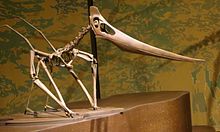| Pteranodontoids | |
|---|---|

| |
| Mounted skeleton of a female Geosternbergia sternbergi | |

| |
| Reconstruction of Ferrodraco lentoni showing the known material, scale bar = 50 mm. | |
| Scientific classification | |
| Domain: | Eukaryota |
| Kingdom: | Animalia |
| Phylum: | Chordata |
| Order: | †Pterosauria |
| Suborder: | †Pterodactyloidea |
| Clade: | †Ornithocheiroidea |
| Clade: | †Pteranodontoidea Kellner, 1996 |
| Subgroups | |
| Synonyms | |
| |
Pteranodontoidea (or pteranodontoids, from Greek meaning "toothless wings") is an extinct clade of ornithocheiroid pterosaurs from the Early to Late Cretaceous (early Valanginian to late Maastrichtian stages) of Asia, Africa, Europe, North America and South America.[1] It was named by Alexander Wilhelm Armin Kellner in 1996. In 2003, Kellner defined the clade as a node-based taxon consisting of the last common ancestor of Anhanguera, Pteranodon and all its descendants. The clade Ornithocheiroidea is sometimes considered to be the senior synonym of Pteranodontoidea, however it depends on its definition.[2] Brian Andres (2008, 2010, 2014) in his analyses, converts Ornithocheiroidea using the definition of Kellner (2003) to avoid this synonymy.[3]
Despite the meaning of the group's name, not all pteranodontoids were toothless, the earlier genera such as the istiodactylids and anhanguerids had teeth that they used to catch prey, and several conclusions had led to the idea that they later evolved into the toothless pteranodontids. Pteranodontoids were also the most diverse group of pterosaurs throughout the Cretaceous period, and therefore the most successful flyers during their time.[4] They were mostly replaced by the larger azhdarchids at the end of the Late Cretaceous however, which resulted in resource and terrain competitions, but even so, pteranodontoids still managed to thrive with them, and genera such as Alcione, Barbaridactylus, and Simurghia lived until the Cretaceous-Paleogene extinction event. Pteranodontoids had similar a similar diet to modern-day soaring birds such the albatross, which mainly consisted of fish. Some genera of this group however, fed mainly on carrion, this can be seen on the earlier genera such as Istiodactylus. They were also known for their proportionally large wingspans, the largest recorded of any pteranodontoid reached 8.70 meters (28.5 ft), and it belongs to the genus Tropeognathus.[5]
- ^ Richard J. Butler; Stephen L. Brusatte; Brian B. Andres & Roger B. J. Benson (2012). "How do geological sampling biases affect studies of morphological evolution in deep time? A case study of the Pterosauria (Reptilia: Archosauria)". Evolution. 66 (1): 147–162. doi:10.1111/j.1558-5646.2011.01415.x. PMID 22220871. S2CID 205783384.
- ^ Unwin, D. M., (2003): On the phylogeny and evolutionary history of pterosaurs. pp. 139-190. — in Buffetaut, E. & Mazin, J.-M., (eds.): Evolution and Palaeobiology of Pterosaurs. Geological Society of London, Special Publications 217, London, 1-347
- ^ Andres, Brian Blake (2014). Systematics of the Pterosauria. Yale University. p. 366. A preview that shows the cladogram without clade names
- ^ Federico L. Agnolin & David Varricchio (2012). "Systematic reinterpretation of Piksi barbarulna Varricchio, 2002 from the Two Medicine Formation (Upper Cretaceous) of Western USA (Montana) as a pterosaur rather than a bird" (PDF). Geodiversitas. 34 (4): 883–894. doi:10.5252/g2012n4a10. S2CID 56002643.
- ^ Kellner, A. W. A.; Campos, D. A.; Sayão, J. M.; Saraiva, A. N. A. F.; Rodrigues, T.; Oliveira, G.; Cruz, L. A.; Costa, F. R.; Silva, H. P.; Ferreira, J. S. (2013). "The largest flying reptile from Gondwana: A new specimen of Tropeognathus cf. T. Mesembrinus Wellnhofer, 1987 (Pterodactyloidea, Anhangueridae) and other large pterosaurs from the Romualdo Formation, Lower Cretaceous, Brazil". Anais da Academia Brasileira de Ciências. 85 (1): 113–135. doi:10.1590/S0001-37652013000100009. PMID 23538956.